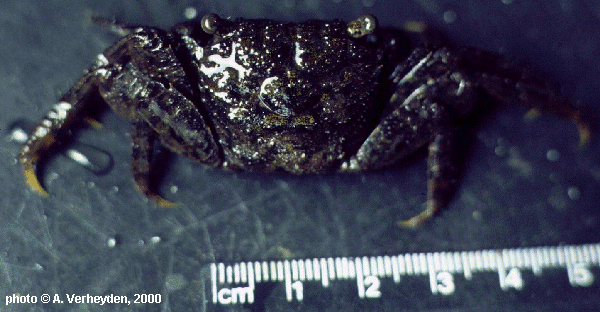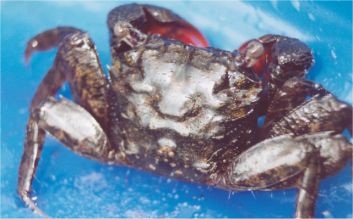|
A field guide to Kenyan
mangroves
|
Perisesarma guttatum (A. Milne Edwards, 1869)
Family: Sesarmidae

Zone: Can be found from A. marina Landward to creek, but primarily resides in muddier regions (Gillikin, 2000).
Habitat: On the forest floor, uses other crabs burrows and natural crevices (Gillikin, 2000).
|
Food: Completely omnivorous, will try to eat anything on forest floor including dropped pencils. Stomach contents are primarily leaves and to a lessor degree insects (Dahdouh-Guebas et al., 1999). Often, P. guttatum were observed picking minuscule items off the sediment surface and bringing it to their mouth-parts (Gillikin, 2000). Ecological notes: Has five zoeal stages lasting from 22-25 days and one megalopa stage (Pereyra Lago, 1993). Very common across entire mangrove forest in high densities, but avoids drier areas; prefers areas with very organic sediment (Gillikin, 2000). Often found in N. smithi burrows (Gillikin, 2000). Very important in leaf litter removal (Slim et al., 1997). Not a shy species (Hartnoll, 1975). Faithful to an area about 16 sq meters during it's life (Skov et al., 2002). Maturity in males reached at a carapace width of about 9.35 mm and 15.3 mm for females (Flores et al., 2002). It should be noted that as this species has been confused with P. samawati until now, most literature dealing with P. guttatum most likely includes both species (see Gillikin & Schubart, 2004). |
|
compare with P. samawati |
Distinguishing characteristics: Claws red, internal palm
bright orange (carapace width about 3 cm); 11-13 tuberlces on the top of
the claw (see images to the left), as compared to P.
samawati which has 7-8 (Gillikin & Schubart, 2004). Note that
Perisesarma guttatum is often referred to as Sesarma guttatum
in the literature. (See list of all Perisesarma
species).
|
Geographical range: Red Sea, Somalia, Kenya, Tanzania, Madagascar (Vannini and Valmori, 1981)

References:
Cannicci, S., F. Dahdouh-Guebas and L. Montemagno, 1993. Field Keys for Kenyan Mangrove Crabs. Museo Zoologico "La Specola", Dipartimento di Biologia Animale e Genetica dell'Università Degli Studi di Firenze, Via Romana 17, I-50125 Firenze, Italia.
Dahdouh-Guebas, F., M. Giuggioli, A. Oluoch, M. Vannini & S. Cannicci, 1999. Feeding habits of non-ocypodid crabs from two mangrove forests in Kenya. Bull. Mar. Sci. 64(2): 291-297.
Flores AAV, Paula J, Dray T. 2003. First zoeal stages of grapsoid crabs (Crustacea: Brachyura) from the East African coast. Zoological Journal of the Linnean Society 137: 355-383.
Flores AAV, Saraiva J, Paula J. 2002. Sexual maturity, reproductive cycles, and juvenile recruitment of Perisesarma guttatum (Brachyura, Sesarmidae) at Ponta Rasa mangrove swamp, Inhaca Island, Mozambique. Journal of Crustacean Biology 22(1): 143-156.
Gillikin, D.P. and C.D. Schubart, 2004. Ecology and systematics of mangrove crabs of the genus Perisesarma (Crustacea: Brachyura: Sesarmidae) from East Africa. Zoological Journal of the Linnean Society 141 (3): 435-445. (REQUEST REPRINT).
Gillikin, D.P., 2000. Factors controlling the distribution of Kenyan brachyuran mangrove crabs: Salinity tolerance and ecophysiology of two Kenyan Neosarmatium species. M.Sc. Thesis, Free University of Brussels, Brussels, Belgium.
Hartnoll, R.G., 1975. The Grapsidae and Ocypodidae (Decapoda: Brachyura) of Tanzania. J. Zool. Lond. 177:305-328.
Pereyra Lago, R.P., 1993. Larval development of Sesarma guttatum A. Milne Edwards (Decapoda: Brachyura: Grapsidae) reared in the laboratory, with comments on larval generic and familial characters. Journal of Crustacean Biology 13(4): 745-762
Skov MW, Vannini M, Shunula JP, Hartnoll RG, Cannicci S. 2002. Quantifying the density of mangrove crabs: Ocypodidae and Grapsidae. Marine Biology 141: 725-732.
Slim, F.J., M.A. Hemminga, C. Ochieng, N.T. Jannink, E. Cocheret de la Morinière and G. van der Velde, 1997. Leaf litter removal by the snail Terebralia palustris (Linnaeus) and sesarmid crabs in an East African mangrove forest (Gazi Bay, Kenya). J. Exp. Mar Bio Ecol 215: 35-48.
Vannini, M. and P. Valmori, 1981. Researchers on the coast of Somalia. The shore and the dune of Sar Uanle. 30. Grapsidae (Decapoda Brachyura). Monitore Zoologico Italiano 6: 57-101.
